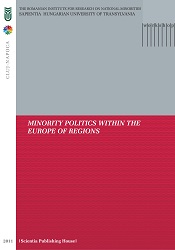Minority Rights and the Dynamics of Europeanisation:
Convergence in the Regional Governance of the Danish-German Border Region or What One Preaches, the Other Practises
Minority Rights and the Dynamics of Europeanisation:
Convergence in the Regional Governance of the Danish-German Border Region or What One Preaches, the Other Practises.
Author(s): H. Tove Malloy
Subject(s): Politics / Political Sciences
Published by: Scientia Kiadó
Summary/Abstract: The politics of regional governance in the Danish-German border region is breaking new grounds for the European minority rights regime. Drawing not only on their well-developed cross-cultural knowledge and natural social capital but also on years of institutionalised intercultural dialogue at various levels, the national minorities have increasingly informed an emerging regional discourse seeking economic development through crossborder institutionalisation and capacity-building (Competence Analysis 2007). When a need for new cross-border infrastructure or service projects is identified, it is often the members of the national minorities that spot the opportunities. When harmonisation of social protection regulation was identified as a major hurdle to labour commute across the border, the national minorities engaged their national heads of governments to address the issue. When the 2007-2013 INTERREG Commission was established, representatives of the national minorities were seated alongside local representatives. When public authorities and local governments meet to review cross-border projects and progress, the national minorities participate. When the Euro-region assembly meet, representatives of the national minorities take their seats as elected officials. This is by no means a ‘best case’ scenario. The national minorities have fought hard for an increased influence through their local commissions and representative offices. Their political parties have been active since the end of World War II (Kühl 2001). And there are still areas where the national minorities are excluded even though their actions complement the ongoing strategydefinition (Competence Analysis 2007). But where the early years saw the minority parties pursuing an emancipation discourse, the broader European integration discourse has seen them turn to regional development (Klatt and Kühl 1999). Thus, years of trust building have enabled a ‘marriage’ between former antagonists in the common pursuit of regional development. This is a pursuit that aims at transforming a region that is still peripheral to nation-states’ economies into a progressive and modern border region. The ultimate goal is a prosperous region that can compete in the ‘new’ regionalism of the European Union (EU) (Keating 1998). But it is a region suffering the legacy of a ‘hard’ security border, even as the Schengen co-operation was initiated in 2001 (Klatt 2006). Thus, a common identity of the people residing in the region does not exist. Biculturalism is, however, everyday life for the national minorities and a united Europe without borders; it is a natural desire, the state boundaries having separated them from their kin-states for centuries. Moreover, a certain ‘Europeanness’ has come to inform their collective identities (Competence Analysis 2007, Malloy 2009). These factors contribute to the desire of elite actors for greater European integration, and thus create a new type of minority-majority politics in the border region. This politics is informed not only by the EU’s cohesion strategy, the Regional Policy, but also by the Council of Europe’s democratisation strategy, especially the Outline Convention. EU Structural Funds played a first role in initiating the cross-border co-operation, and the establishment of a Euro-region institutionalised the partnership. But it was the Council of Europe’s normative framework on minority rights, the Framework Convention, which became, if not key, at least a major factor in ensuring national minority participation in this co-operation. There is thus reason to argue that the intersection of these integration strategies makes for a view that the democratisation narrative on minority rights converges with the Europeanisation narrative in this border region.Although neither the EU’s Regional Policy nor the Council of Europe’s Outline Convention provisions national minority rights; they nonetheless address an issue of European integration that is contingent, namely the co-operation across state boundaries that for years has separated national minorities from their kin-states. Coupled with the ongoing implementation of the normative framework on minority rights ratified by both nationstates, this paper argues that the convergence of these narratives lends itself to support a different view of the European minority rights regime, a view based not as heretofore on normative frameworks but also on the dynamics of Europeanisation. Europeanisation is seen here not in terms of outward expansion of European values but as the ex post process of entrenching European values through deepened inward integration. The paper will describe and analyse the new type of minority-majority politics in the Danish-German border region with specific focus on the actions and functions of the national minorities in relation to the border region’s development strategy. It will be argued that because this new type of minority-majority politics is rooted in minority rights and functions on the basis of the core tenets of diversity and pluralism in European values, it speaks not only to the dynamics of Europeanisation but also puts the European minority rights regime in a new light.
Book: MINORITY POLITICS WITHIN THE EUROPE OF REGIONS
- Page Range: 37-59
- Page Count: 23
- Publication Year: 2011
- Language: English
- Content File-PDF

